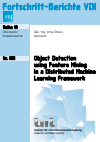Object Detection using Feature Mining in a Distributed Machine Learning Framework
Zusammenfassung
This dissertation addresses the problem of visual object detection based on machine-learned classifiers. A distributed machine learning framework is developed to learn detectors for several object classes creating cascaded ensemble classifiers by the Adaptive Boosting algorithm. Methods are proposed that enhance several components of an object detection framework: At first, the thesis deals with augmenting the training data in order to improve the performance of object detectors learned from sparse training sets. Secondly, feature mining strategies are introduced to create feature sets that are customized to the object class to be detected. Furthermore, a novel class of fractal features is proposed that allows to represent a wide variety of shapes. Thirdly, a method is introduced that models and combines internal confidences and uncertainties of the cascaded detector using Dempster’s theory of evidence in order to increase the quality of the post-processing.
...
Schlagworte
- Kapitel Ausklappen | EinklappenSeiten
- I–XIV
- 1–15 1 Introduction 1–15
- 16–27 2 Related Work and Data Sets 16–27
- 2.1 Machine Learning for Visual Object Detection
- 2.1.1 Feature Provision
- 2.1.2 Learning Algorithms
- 2.2 Data Sets and Benchmarks
- 28–61 3 Fundamentals 28–61
- 3.1 Common Features
- 3.1.1 Haar-like Features
- 3.1.2 Histograms of Oriented Gradients
- 3.1.3 FromFeatures to Classifiers
- 3.2 Supervised Machine Learning
- 3.2.1 Adaptive Boosting
- 3.2.2 Viola and Jones Detection Framework
- 3.2.3 Margin Analysis
- 3.2.4 Variants of Boosting Algorithms
- 3.3 Data Analysis
- 3.3.1 Cluster Analysis
- 3.3.2 Principal Component Analysis
- 3.4 Detector PerformanceMeasures
- 62–67 4 Distributed Machine Learning Framework 62–67
- 68–75 5 Learning from Sparse Training Data 68–75
- 5.1 Training Data Augmentation
- 5.2 Experimental Results
- 5.2.1 Experiments on Face Detection
- 5.2.2 Experiments on Cell Data Set
- 5.3 Discussion
- 76–89 6 Fractal Integral Paths 76–89
- 6.1 Boosted Fractal Integral Paths
- 6.1.1 Fractals
- 6.1.2 Fractal Features
- 6.1.3 Fractal Properties
- 6.1.4 Construction of Fractals
- 6.1.5 Feature Types
- 6.2 Experimental Results
- 6.2.1 Face Detection
- 6.2.2 Microscopic Cell Detection
- 6.2.3 Training and Computing Time
- 6.3 Discussion
- 90–120 7 Multi-Feature Mining for Detector Learning 90–120
- 7.1 2Rec Features
- 7.2 Keypoint HOG Features
- 7.3 Experimental Results
- 7.3.1 Face Detection
- 7.3.2 Lateral Car Detection
- 7.3.3 Pedestrian Detection
- 7.3.4 Insights into the Training Process
- 7.4 Discussion
- 121–130 8 Non-Maximum Suppression using Dempster’s Theory of Evidence 121–130
- 8.1 Merging Multiple Detections based on Dempster’s Theory
- 8.1.1 Cascaded Classifier
- 8.1.2 Dempster-Shafer Theory of Evidence
- 8.1.3 Joint Confidence based on Dempster-Shafer
- 8.1.4 Confidence-based Detection Merging
- 8.2 Experimental Results
- 8.2.1 Face Detection
- 8.2.2 Lateral Car Detection
- 8.3 Discussion
- 131–134 9 Conclusion 131–134
- 135–137 A Lindenmayer Systems Defining Fractal Integral Paths 135–137
- A.1 L-System Defining Gosper Curve
- A.2 L-System Defining E-Curve
- 138–152 Bibliography 138–152


